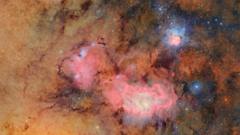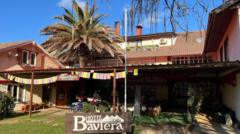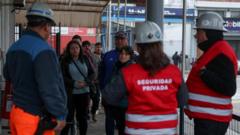The powerful Vera C. Rubin Observatory in Chile has unveiled its first celestial images, showcasing the breathtaking splendor of the universe like never before. Within these initial snapshots, colorful gas and dust clouds swirl in star-forming regions located an astonishing 9,000 light years away from Earth. This state-of-the-art telescope, armed with the most powerful digital camera in the world, is set to revolutionize our understanding of the cosmos.
With its capabilities, the observatory has a stellar mission ahead—it aims to identify the elusive "ninth planet" of our solar system and detect potentially hazardous asteroids within striking distance of Earth. The telescope will also conduct extensive mapping of the Milky Way while tackling fundamental questions regarding dark matter, the enigmatic substance that makes up a significant portion of the universe.
Astronomer Professor Catherine Heymans described this moment as a "once-in-a-generation" milestone for the field of astronomy, having dedicated nearly 25 years to the construction of this impressive facility. The UK is a prominent partner in the venture and will manage the data centers that operationalize the detailed images captured as the telescope scans the night sky.
Located on Cerro Pachón in the Chilean Andes, the observatory benefits from exceptional conditions for stargazing—high altitude, aridity, and darkness. To maintain optimal observational conditions, meticulous care is taken to preserve the darkness around the telescope, including navigating the access roads at night with minimal lighting.
The observatory's technical prowess includes a 3,200-megapixel camera capable of capturing extraordinary details, with the potential to identify objects tens of millions of light-years away. The camera’s unique three-mirror design allows for high light capture, essential for observing distant astronomical phenomena.
Operated in a continuous 10-year Legacy Survey of Space and Time, the telescope will image the night sky roughly every 40 seconds, aiming to acquire up to 10 million alerts each night. This unprecedented data stream will enable scientists to monitor changes in the cosmos, unravel the formation of the Milky Way, and explore the ancient secrets of distant galaxies.
The observatory will pay special attention to transient events, capitalizing on its ability to repeatedly survey the same regions and alert scientists to any changes or anomalies. Such surveillance is vital for identifying dangerous asteroids, while the large mirrors will assist in detecting faint light signals from objects traversing space.
Excited astronomers are eager to delve into the data produced by Vera Rubin, potentially extending the observable reach of the Milky Way from 163,000 light-years to an incredible 1.2 million light-years. Furthermore, the telescope is believed to possess the capability to finally shed light on the long-speculated Planet Nine, a possible astronomical body located far beyond the Sun's orbit.
Professor Heymans expressed enthusiasm for the exploration ahead, remarking on the immense potential that this new observatory holds for advancing the field of astronomy. As data begins to flow in from this cutting-edge facility, a new era in cosmic discovery is set to unfold.
With its capabilities, the observatory has a stellar mission ahead—it aims to identify the elusive "ninth planet" of our solar system and detect potentially hazardous asteroids within striking distance of Earth. The telescope will also conduct extensive mapping of the Milky Way while tackling fundamental questions regarding dark matter, the enigmatic substance that makes up a significant portion of the universe.
Astronomer Professor Catherine Heymans described this moment as a "once-in-a-generation" milestone for the field of astronomy, having dedicated nearly 25 years to the construction of this impressive facility. The UK is a prominent partner in the venture and will manage the data centers that operationalize the detailed images captured as the telescope scans the night sky.
Located on Cerro Pachón in the Chilean Andes, the observatory benefits from exceptional conditions for stargazing—high altitude, aridity, and darkness. To maintain optimal observational conditions, meticulous care is taken to preserve the darkness around the telescope, including navigating the access roads at night with minimal lighting.
The observatory's technical prowess includes a 3,200-megapixel camera capable of capturing extraordinary details, with the potential to identify objects tens of millions of light-years away. The camera’s unique three-mirror design allows for high light capture, essential for observing distant astronomical phenomena.
Operated in a continuous 10-year Legacy Survey of Space and Time, the telescope will image the night sky roughly every 40 seconds, aiming to acquire up to 10 million alerts each night. This unprecedented data stream will enable scientists to monitor changes in the cosmos, unravel the formation of the Milky Way, and explore the ancient secrets of distant galaxies.
The observatory will pay special attention to transient events, capitalizing on its ability to repeatedly survey the same regions and alert scientists to any changes or anomalies. Such surveillance is vital for identifying dangerous asteroids, while the large mirrors will assist in detecting faint light signals from objects traversing space.
Excited astronomers are eager to delve into the data produced by Vera Rubin, potentially extending the observable reach of the Milky Way from 163,000 light-years to an incredible 1.2 million light-years. Furthermore, the telescope is believed to possess the capability to finally shed light on the long-speculated Planet Nine, a possible astronomical body located far beyond the Sun's orbit.
Professor Heymans expressed enthusiasm for the exploration ahead, remarking on the immense potential that this new observatory holds for advancing the field of astronomy. As data begins to flow in from this cutting-edge facility, a new era in cosmic discovery is set to unfold.
















